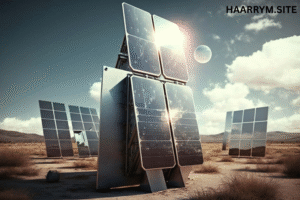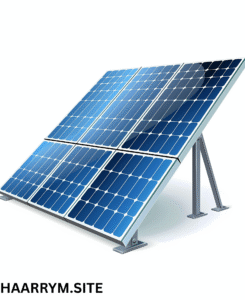One frequently disregarded but vital element in a solar system design as solar energy acceptance increases worldwide is the solar panel stand. Solar panels provide electricity, but the stand controls their efficiency. Having the correct stand can greatly improve performance, lifetime, and safety whether you are putting panels in a business building, on your rooftop, in your garden, or elsewhere.
This tutorial will lead you through the many kinds of solar panel stands, the materials used, installation advice, and how to pick the best solar panel stand in 2025 depending on your particular energy demands.
Describe a Solar Panel Stand
A solar panel stand is a structural support mechanism keeping solar panels at the ideal angle to maximise sunlight intake. Made of aluminium, galvanised steel, or iron, it may be permanent or changeable. The panels must remain stable and operate at maximum efficiency so these stands are very crucial.
Why Is a Solar Panel Stand Crucially Important?
The following are some main reasons investing in a premium solar panel stand counts:
-
Optimises Energy Output: The stand orientates the panel to maximise sunlight by optimal tilt and angle.
-
Protection from Elements: A strong stand protects the solar panels from environmental elements like wind, severe rain, snow, and other forces.
-
Increases Lifespan: Prevents structural damage brought on by improperly installed systems.
-
Easy Maintenance: Provides easy cleaning, inspection, and panel servicing when required, therefore enabling better maintenance.
Variations of Solar Panel Stands
1. Rooftop Solar Panel Stand
These are made especially for installing either sloping or flat panels on roofs.
-
Often a tilt mechanism is needed to angle the panels on a flat roof.
-
Sloped roof mounts allow one to line the panel with the angle of the roof.
-
Perfect for residential and business roofs with limited area.
2. Ground-Mounted Solar Panel Platform
This kind is placed straight on the ground either with concrete or pole foundations.
-
Standard Ground Mounts: Panels are secured on somewhat tilting racks.
-
Pole Mounts: For more sun monitoring, panels are set atop single or dual-axis poles.
-
Best For: Open land regions or farms where enough sunshine is received.
3. Changeable Solar Panel Platform
Depending on the season or sun movement, they let you manually or automatically adjust the solar panel angle.
-
Manual Adjustment: Change degrees a few times a year using hand tilt adjusters.
-
Tracking Systems: Automatically rotate the panels to maximise efficiency by following the sun.
-
Best For: Users seeking high energy production or areas with seasonal solar fluctuations.
Products Applied in Solar Panel Stands
Long-term durability and cost-effectiveness depend on the proper material choice. The following are some likely materials utilised in 2025:
1. Aluminium
-
Lightweight, rust-resistant, simple to install.
-
Not uncommon in homes.
2. Galvanised Steel
-
Better than aluminium and perfect for more big commercial or industrial installations.
-
Resistant to strong environmental conditions.
3. Iron
-
Robust and heavy, but if not maintained correctly it may rust easily.
-
Applied in systems with high load bearing.
Considerations Regarding the Solar Panel Stand Selection
1. Location and Surface
-
Different kinds of platforms are needed for rooftop versus ground-mounted installations.
-
Often flat surfaces need for tilting systems.
2. Load-Bearing Capacity
-
Make sure the stand can handle local wind and snow loads as well as the weight of the solar cells.
3. Tilt Angle
-
Fixed-angle stands should line up with the latitude of your location.
-
Year-round efficiency is better provided by adjustable stands.
4. Corrosion Reversal
-
Particularly crucial in coastal or wet regions.
-
Choose covered metal or rust-proof materials.
5. Maintenance and Installation Simplicity
-
Installation of prefabricated, modular systems is simpler.
-
Search for designs that provide cleaning and inspection access to panels easily.
Is It Worth It? DIY Solar Panel Stand
If you are a hands-on homeowner, you may want to create your own do-it-yourself solar panel stand. You should know the following:
Benefits
-
Reasonably affordable
-
Completely flexible
-
Gain useful abilities
Cons
-
Time-consuming
-
Calls for tools and sophisticated knowledge in technology
-
Risk of wrong installation influencing effectiveness
A do-it-yourself arrangement could work for off-grid cottages or small installations. Professional-grade stands, however, guarantee safety and improved long-term performance whether used for homes or businesses.
Step-by-Step Solar Panel Stand Installation Guide
The following is a general guide of the ground-mounted stand installation process:
-
Site Survey: Check soil quality, shadows, and sunshine exposure.
-
Foundation: Dig holes and pour concrete for base support.
-
Frame Construction: Create the frame using nuts, bolts, and braces.
-
Panel Attachment: Fasteners or clamps will help you to secure the panels.
-
Angle Adjustment: Geographic location will determine the proper tilt angle to be used.
-
System Connection: Connect to the inverter then test the system.
Always review local construction regulations and solar installation recommendations.
2025 Solar Panel Stand Price
Size, material, and adaptability all influence price:
| Type | Material | Price Range (USD) |
|---|---|---|
| Fixed Aluminium Rooftop Stand | Aluminium | $50 to $150 per panel |
| Ground Mount Stand | Steel | $100 to $300 per panel |
| Flexible Platform | Mixed | $150 to $500 per panel |
| Monitoring Stand | High-grade Aluminum/Steel | $500 to $1,200 per panel |
Always take whole project cost—including labour, delivery, and foundation work—into account.

Top Brands for Stands Made of Solar Panels by 2025
-
Unirac: Noted for simple installation and rooftop installations.
-
IronRidge: Popular for use in homes as well as businesses.
-
Schletter: German-made, premium ground and rooftop structures.
-
Renogy: Provides RVs and off-grid usage portable and do-it-yourself solar panel platforms.
In Essence, Selecting a Solar Panel Stand Depends On…
Though it seems like a minor component of the solar energy configuration, a solar panel stand is very essential for optimising output and guaranteeing system lifetime. The appropriate decision will pay off in energy savings and peace of mind whether your preferred mount is permanent, movable stand, or automated tracking system.
When you design your solar installation in 2025, consider not just the panels but also the time and money you should spend selecting a dependable solar panel stand that fits your system size, environmental conditions, and energy targets.
Frequently Asked Questions Regarding Solar Panel Stands
Q1: A solar panel stand’s perfect tilt angle is what?
A: That depends on the latitude of your location. For year-round effectiveness, generally it should match your latitude.
Q2: Are solar panels mountable without a stand?
A: Though it’s not advised, technically yes. Efficiency and safety are sacrificed without a correct posture.
Q3: How long does a solar panel stand last?
A: A 25–30 year lifetime for premium metal supports matches or even surpasses that of the panels themselves.
Q4: Does the investment in a tracking solar stand pay off?
A: Indeed for big commercial settings or places with changing solar angles. Usually enough for modest home systems is fixed or manual tilt.
